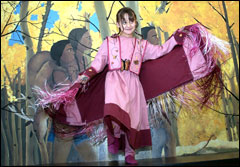|
|
Canku Ota |
|
|
(Many Paths) |
||
|
An Online Newsletter Celebrating Native America |
||
|
April 17, 2004 - Issue 111 |
||
|
|
||
|
NATIVE DRESS |
||
|
by SHAWN WHITE WOLF - The
(Helena, MT) Indendent Record Staff Writer
|
||
|
credits: photo:
Jazmyne Lee Brave dances in an authentic native American dress she
and academic support teacher, Tammara Rosenleaf, made as part of
Jazmyne's cultural studies at Wakina Sky. - Eliza Wiley IR Staff
Photographer
|
|
Wakina Sky instructor makes traditional clothing part of class
With that in mind, Wakina Sky Learning Circle's Tammara Rosenleaf, who is of Scottish and Swedish heritage, has found a deep connection to the hearts and dreams of some of Helena's local Indian girls and their traditional dresses. With degrees in fashion and teaching, Rosenleaf said, the biggest lesson she's learned while working with Indian children is the way Indian people do things as a process, rather than in a timeframe. For example, Rosenleaf last week completed a dress tailored to the individuality of second-grader Jazmyne Lee Brave, a Chippewa Cree and Assiniboine Sioux.
Rosenleaf said it took more than 70 hours to complete. If she were ever to make a similar dress and sell it on the market, it would bring hundreds of dollars. "If it sold for $400, I'd only be making pennies," she said. Nationally, traditional Indian clothing can be priced as high as several thousand dollars because of the amount of time and work that goes into each outfit. Women's clothing was always designed to mirror the greatest characteristics of each woman, their creator, the world, their tribe and their people. Every bead, shell, color and shape was detailed to represent some aspect of their inner selves. While the tradition continues, more and more people, both Indian and non-Indian, with genuine interest in Indian fashion and clothing design are learning to examine and produce more authentic styles of Indian clothing. Just over one year ago, Rosenleaf with her husband and two dogs, returned to Montana from Washington state to begin working as an academic support teacher for the Indian children at Wakina Sky. An Anaconda native, Rosenleaf said she grew up with a genuine interest in Indian history. In the early 1900s, Chippewa Cree Indians from Rocky Boy were known to spend the winter months by the hot springs near Anaconda. In the local historical museum, photos of traditionally dressed Indian men, women and children walking or riding their horses down the bustling Anaconda streets are displayed as part of the town's history. After moving to Great Falls, Rosenleaf attended Longfellow Elementary School where she said she befriended many of the local Indian children. Longfellow has always maintained a higher percentage of Indian children than the rest of the elementary schools in Great Falls since a large number of Indian families live in that area of town. Today, one of the oldest and nationally recognized Indian libraries in the United States is located in the Longfellow school building. Yet, when Rosenleaf started working at Wakina Sky, she said, she knew nothing about Indian clothing. "I can do what's told, but I had a lot of help from moms, Wakina Sky and others," she said. She admits she doesn't know all the Indian traditions, but works with the child's parents to learn what's right for the child and their specific culture. Currently, there are eight different tribes represented in the Wakina Sky program. With the help of local elders, Rosenleaf will help the children understand how to wear their dresses, how to act while wearing them and how to care for the clothing. In addition, Rosenleaf has helped put together and worked on other types of Indian clothing, including men's traditional and pow wow clothing styles. "If anyone wants to help with donations, the fabric and gift cards from Jo-Ann Fabrics have been a real big help," said Rosenleaf. |
|
|
www.expedia.com |
|
|
||
|
|
||
| Canku Ota is a free Newsletter celebrating Native America, its traditions and accomplishments . We do not provide subscriber or visitor names to anyone. Some articles presented in Canku Ota may contain copyright material. We have received appropriate permissions for republishing any articles. Material appearing here is distributed without profit or monetary gain to those who have expressed an interest. This is in accordance with Title 17 U.S.C. Section 107. | ||
|
Canku Ota is a copyright © 2000, 2001, 2002, 2003, 2004 of Vicki Lockard and Paul Barry. |
||
 |
 |
|
|
The "Canku Ota - A Newsletter Celebrating Native America" web site and its design is the |
||
|
Copyright © 1999, 2000, 2001, 2002, 2003, 2004 of Paul C. Barry. |
||
|
All Rights Reserved. |
||
 For
centuries, the beauty of American Indian women was always complemented
by the style of clothing they wore, specifically designed to show
their great pride, dignity, and hope.
For
centuries, the beauty of American Indian women was always complemented
by the style of clothing they wore, specifically designed to show
their great pride, dignity, and hope.